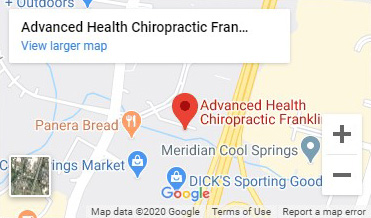If you have never had a chiropractic adjustment, you may have heard some friends talk about some things that concern you. One of them is whether or not chiropractic adjustments hurt.
If you have concerns on whether Chiropractic will hurt, or if you have an ongoing issue that you are hoping to resolve, please give us a call so we can talk through your concerns. We’re located in Franklin, TN for easy access.
Here’s a list of some of those things brought up quite commonly and their explanations:
Joints are going to ‘pop’ when they are adjusted. The ‘pop’ hurts. (myth)The pop is related to nitrogen gas that is found inside the joints. It’s similar to how bubble wrap has little pockets of air, and when they are pressed, the air releases, and there’s a popping noise.
Your chiropractor will press on the joints, and the air inside them may release the popping noise. However, there’s no pain associated with the popping, only relief.
And not all patients will hear the popping sound, and not all joints will cause the popping sound.
Concern: Chiropractors take your joint to the limit before they adjust it. This causes pain. (not exactly true)
When a joint is moved in its normal range of motions, there should be no pain or limitation of movement, when there has been an injury, the body ‘braces’ itself by limiting movement so that no further damage will be done.
When you have an injury, you will feel your body stiffen in the muscles surrounding the joint. Then when your chiropractor tests your joint movement, you may feel the stiffening of the muscles even more. This is an involuntary reaction.
When your chiropractor adjusts your joint, there must be little stiffness. Any stiffness you add to the muscles involuntarily will make the joint more resistant to the adjustment. And whenever there is stiffness accompanying an adjustment, there will be momentary pain – until the adjustment is finished.
If you do feel that momentary – 2-second pain during the adjustment, you can rest assured that you will feel relief, calmness, happiness, and a sense of well being shortly afterward. There will also generally a sense of increased range of motion in that joint
Concern:If you’ve had an injury to a body part, chiropractors might decide to adjust the injured area, and that could hurt.
This is a common thought. When you hurt your shoulder, the last thing you want someone to do is touch the area because it hurts so much. You’re sensitive to pain. What you do not understand is that there’s a difference in the touch from a chiropractor and the touch of someone who is not trained in how the body works.
A chiropractor is trained in how to align joints. When a joint is out of alignment, it will hurt. That’s because the joint receptors are screaming out for help – and the pain is the signal for help. A chiropractor will realign the joint with a very quick adjustment. The pain you may feel is from the touch of anyone, but with the chiropractor, it will last fewer than 2-3 seconds. Some patients never feel the pain, but only a stretching sensation.
Here’s an example of how it works with pain and misalignment: You sprain your shoulder while carrying something. Your shoulder has a lot of pain. You don’t do anything about it except put ice on it. The pain of injury lasts for months. Then you finally decide to go to the chiropractor.
He finds out that your back is out of alignment and adjusts you. You feel momentary pain (<2 seconds) when he first adjusts the area, but it leaves rapidly.
Soreness may last for a day or two but generally decreases quickly as proper blood flow returns and the area heals. All it took was that momentary adjustment to get you back on track.
Are Adjustments Safe?
Adjustments are safe.
There have been dozens of studies on chiropractic adjustments. Complications or even side effects are rare and do not occur anywhere near the rate of complications and side effects from taking medications. Chiropractic is a natural form of healing that is drugless and eliminates pain, as well as many different issues that affect the physical body.
Chiropractors can sometimes help the following conditions:
• Neck and back pain
• Pain in the chest, ribs, abdomen
• Pain in the shoulders, arms, elbows, wrists, and hands
• Pain in the hips, legs, knees, feet, and toes
• Scoliosis
• Injuries and trauma to the head and neck (whiplash) as well as the rest of the body
• Nervous system disorders
• Pain from conditions caused by diabetes (peripheral neuropathy)
• Injuries from repetitive motions
• Arthritis, bursitis, and tendonitis
• Sports injury
Who Do I See – A Chiropractor or A Medical Doctor?
One additional concern people have about chiropractic is whether or not they can see a chiropractor simultaneously with a medical doctor. The answer is yes, you can. In fact, chiropractors will be happy to tell you how much they can help you and where medical treatment will fill in the gap. They will refer you to a medical doctor if your case warrants this.
Their patients may choose to either go to the chiropractor first. Then they will wait it out and see how much healing occurs before going to the medical doctor. Other patients may see both practitioners simultaneously. And another set of patients will see what type of results they can get from the medical doctor first before they see the chiropractor.
Making an educated choice of what to do for your whole treatment can be made with your chiropractor. And when you work with him or her as part of your team, you will see how easy it is to work well with trained professionals who really want to see you return totally back to health.


